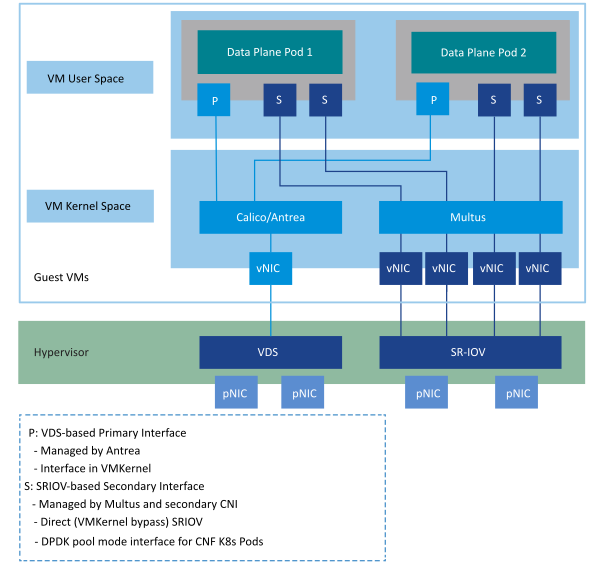With VMware Telco Cloud Platform, you can use DPDK binding with SR-IOV passthrough network device in the Worker Nodes. The SR-IOV passthrough network device in a Worker Node is backed by an SR-IOV Virtual Function (VF) in ESXi. Hence, the Secondary Network interface on the data plane Pods must support network attachment on SR-IOV VF.
With SR-IOV, the Worker Node and the physical NIC adapter bypass the VMKernel in the ESXi and exchange data directly. Bypassing the VMkernel for networking reduces the latency and improves the CPU efficiency for high data transfer performance.

With SR-IOV enabled in the Infrastructure layer (BIOS and NIC), the SR-IOV usage model in the CaaS layer is CNF driven. Ensure that the data plane CNF has SR-IOV and DPDK requirements defined in its CSAR package. Telco Cloud Automation uses SR-IOV and DPDK requirements from the CSAR of the CNF and applies the following node customizations during CNF onboarding:
Add the SR-IOV VF interfaces to the Worker Nodes.
Bind the SR-IOV VF interfaces to DPDK in the Worker Nodes.
Publish the DPDK bound SR-IOV VF interfaces as named allocatable network resources in the Kubelet by using the SR-IOV network device plug-in.
The CNF uses an allocatable network resource (DPDK-bound SR-IOV VF interface) to create a Secondary Network attachment on the data plane Pod.
Ensure that you use VMware compatible NICs, firmware, and driver for SR-IOV. For information about compatible versions, see the VMware Compatibility Guide.
The following node customizations are required for using Secondary Network with SR-IOV and DPDK on the data plane Pod:
Add the following attributes for new network devices under network: devices:
deviceType with value sriov
dpdkBinding with value igb_uio
Other network device attributes such as resourceName, networkName, and count provide an easy network resource consumption model for the CNF. For more information, see Node Customization in the TCA documentation.
If you use SR-IOV, several virtualization features such as vMotion, High Availability, DRS, and Snapshots become unavailable. For more information, see SR-IOV support in the vSphere documentation.